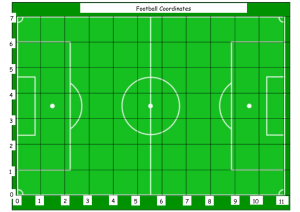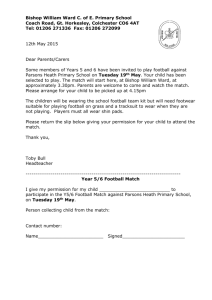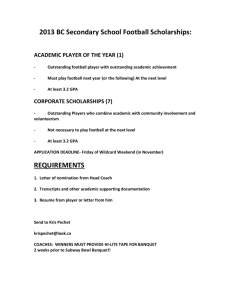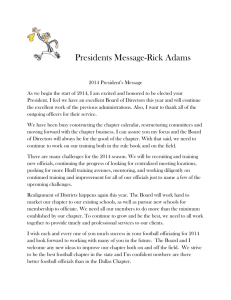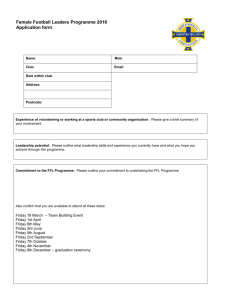PDF - SAS Publishers
advertisement
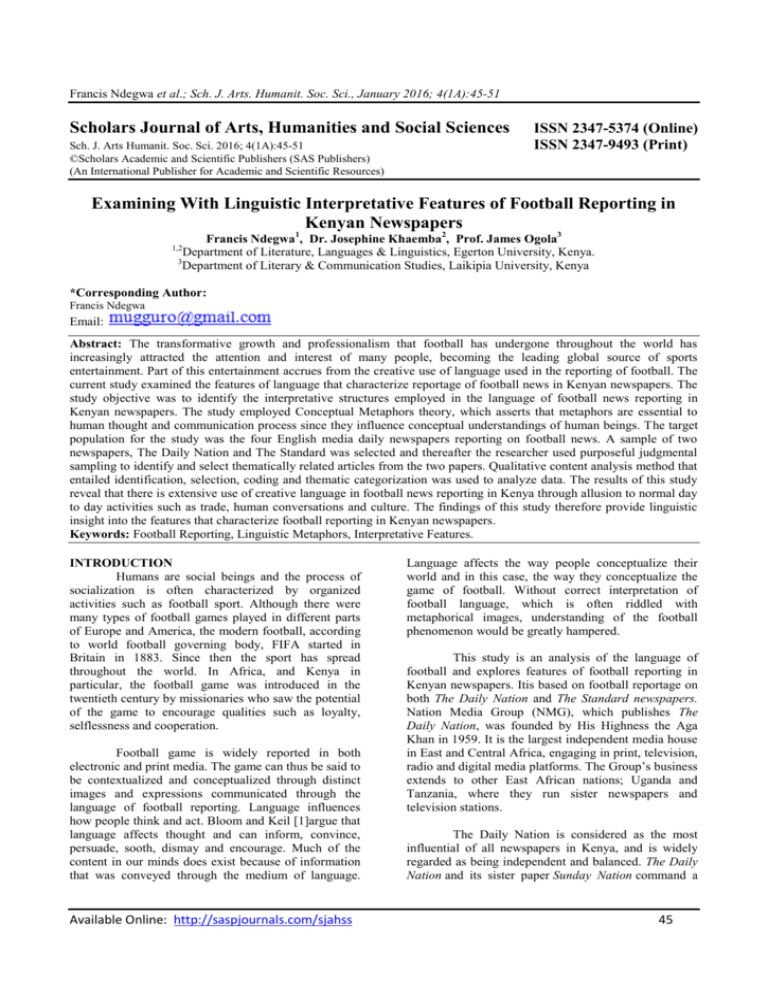
Francis Ndegwa et al.; Sch. J. Arts. Humanit. Soc. Sci., January 2016; 4(1A):45-51 Scholars Journal of Arts, Humanities and Social Sciences Sch. J. Arts Humanit. Soc. Sci. 2016; 4(1A):45-51 ©Scholars Academic and Scientific Publishers (SAS Publishers) (An International Publisher for Academic and Scientific Resources) ISSN 2347-5374 (Online) ISSN 2347-9493 (Print) Examining With Linguistic Interpretative Features of Football Reporting in Kenyan Newspapers Francis Ndegwa1, Dr. Josephine Khaemba2, Prof. James Ogola3 Department of Literature, Languages & Linguistics, Egerton University, Kenya. 3 Department of Literary & Communication Studies, Laikipia University, Kenya 1,2 *Corresponding Author: Francis Ndegwa Email: Abstract: The transformative growth and professionalism that football has undergone throughout the world has increasingly attracted the attention and interest of many people, becoming the leading global source of sports entertainment. Part of this entertainment accrues from the creative use of language used in the reporting of football. The current study examined the features of language that characterize reportage of football news in Kenyan newspapers. The study objective was to identify the interpretative structures employed in the language of football news reporting in Kenyan newspapers. The study employed Conceptual Metaphors theory, which asserts that metaphors are essential to human thought and communication process since they influence conceptual understandings of human beings. The target population for the study was the four English media daily newspapers reporting on football news. A sample of two newspapers, The Daily Nation and The Standard was selected and thereafter the researcher used purposeful judgmental sampling to identify and select thematically related articles from the two papers. Qualitative content analysis method that entailed identification, selection, coding and thematic categorization was used to analyze data. The results of this study reveal that there is extensive use of creative language in football news reporting in Kenya through allusion to normal day to day activities such as trade, human conversations and culture. The findings of this study therefore provide linguistic insight into the features that characterize football reporting in Kenyan newspapers. Keywords: Football Reporting, Linguistic Metaphors, Interpretative Features. INTRODUCTION Humans are social beings and the process of socialization is often characterized by organized activities such as football sport. Although there were many types of football games played in different parts of Europe and America, the modern football, according to world football governing body, FIFA started in Britain in 1883. Since then the sport has spread throughout the world. In Africa, and Kenya in particular, the football game was introduced in the twentieth century by missionaries who saw the potential of the game to encourage qualities such as loyalty, selflessness and cooperation. Football game is widely reported in both electronic and print media. The game can thus be said to be contextualized and conceptualized through distinct images and expressions communicated through the language of football reporting. Language influences how people think and act. Bloom and Keil [1]argue that language affects thought and can inform, convince, persuade, sooth, dismay and encourage. Much of the content in our minds does exist because of information that was conveyed through the medium of language. Available Online: http://saspjournals.com/sjahss Language affects the way people conceptualize their world and in this case, the way they conceptualize the game of football. Without correct interpretation of football language, which is often riddled with metaphorical images, understanding of the football phenomenon would be greatly hampered. This study is an analysis of the language of football and explores features of football reporting in Kenyan newspapers. Itis based on football reportage on both The Daily Nation and The Standard newspapers. Nation Media Group (NMG), which publishes The Daily Nation, was founded by His Highness the Aga Khan in 1959. It is the largest independent media house in East and Central Africa, engaging in print, television, radio and digital media platforms. The Group‟s business extends to other East African nations; Uganda and Tanzania, where they run sister newspapers and television stations. The Daily Nation is considered as the most influential of all newspapers in Kenya, and is widely regarded as being independent and balanced. The Daily Nation and its sister paper Sunday Nation command a 45 Francis Ndegwa et al.; Sch. J. Arts. Humanit. Soc. Sci., January 2016; 4(1A):45-51 market share of 53% per cent compared nearest competitor, The Standard by a ratio of than 2:1 [2]. The Daily Nation also maintains an active website where online editions of the newspapers are published. The cite registers over 3 million daily page views. The Standard, on the other hand, is the oldest newspaper in Kenya. It was established in 1902 by Alibhai Mulla Jeevanjee. Currently, it is owned by The Standard Group,which also runs the Kenya Television Network (KTN), Radio Maisha, the County Weekly (a bi-weekly county-focused newspaper) and Standard Digital World which is its online platform. It commands a market share of 30 percent. Both The Daily Nation and The Standard newspapers are extremely influential with regard to setting the national, political and social agenda. They are considered to hold high journalistic standards and enjoy a reputation of a generally reliable source of news in Kenya and in the region. LITERATURE REVIEW AND THEORETICAL FRAMEWORK Although there were several traditional sports activities, Gitonga and colleagues [3] note that most of the modern games such as football were introduced into Kenya by the British colonialists, settlers and missionaries in the first half of the 20th Century. Since then, sporting activities continue to play a significant role in the development of the nation. The game of football has been identified with improved physical fitness, good health, nation building, and cooperation, capacity for excellence and positive image, [4]. Mwisukha and colleagues[5] note that football has continued to play an invaluable role of enhancing political tranquility in Kenya as a neutral tool of minimizing political tension and differences thereby paving way for collective effort toward the development of various sectors of the country. Mwisukha [6] also notes that the government of Kenya recognizes the importance of sports such as football in building capacities both in individuals and communities that enable them to participate effectively in socio-economic development. Furthermore, football plays a key role in poverty reduction through creation of direct employment and related investment opportunities and is also an important avenue for information dissemination on matters of national interest. Football games are mostly played by young people as a recreational activity. Ongong‟aand colleagues[7] note that recreational activities such as engaging in football games are important for the psychological and physical development of the youth since they contribute to their personal development by promoting good health, personal discipline, and leadership and team skills. In addition, they also provide enjoyment. Available Online: http://saspjournals.com/sjahss Kenya‟s football has consistently attracted the attention of football fans who jam football arenas to witness live tournaments. Many others follow the action on television, currently made possible through sponsorship of Supersport television channel while others will still ardently keep updated through their radio receivers. The study employed the Conceptual Metaphor Theory, also commonly referred to as Cognitive Metaphor Theory propagated by Lakoff and Johnson [8]. The basic tenet of the theory is that metaphor operates at the level of thinking where an individual uses one idea and links it to another to better understand something. The scholars argue that most of our ordinary conceptual system is metaphorical in nature thus; metaphors are integral and not peripheral to language and understanding. Lule [9] argues that metaphors are essential to human thought and communication and that they are extremely influential on conceptual understandings of human beings. For this reason, they are often unavoidable in language. The metaphorical concepts, according to Lakoff and Johnson [10], “structure what we perceive, how we get around in the world, and how we relate to other people”. The nature of human communication can therefore be fundamentally said to be metaphorical. Metaphors often serve as the only way for humans to comprehend complex concepts such as life, death, sickness, health, war and peace [11]. Because our conceptual systems are central to the way we interact with the world, and these systems are largely metaphorical, our thoughts, experiences and interactions with others are hugely reliant on metaphors [12]. Ricoeur [13] argued that words become metaphorical in specific contexts when opposed to other words taken literally. Metaphors, through language, help to construct realities and can serve as guides for future understandings [14]. Metaphors are a matter of thought and not merely of language (hence the use of the term conceptual metaphor) and they consists of words or other linguistic expressions that come from the terminology of the more concrete conceptual domain. Metaphors play an important role in human thought, understanding or even creating our social, cultural, and psychological reality, because they are used effortlessly by ordinary people in everyday life. Attempting to understand metaphor means understanding what kind of world we live in. As a basic cognitive structure, metaphor helps us understand a relatively abstract concept by means of more concrete concept. Metaphors are therefore not merely linguistic expressions but are important tools that relate our experiences of different concepts, making all metaphors a result of how we view the world. Conceptual 46 Francis Ndegwa et al.; Sch. J. Arts. Humanit. Soc. Sci., January 2016; 4(1A):45-51 metaphors help people understand abstract subjects of such central importance as life and communication. It is therefore necessary to study the conventional, frequent metaphorical expressions that are used by communities, and in this case the newspaper language of football reporting. This kind of study does provide clues to the conceptual structures that both reflect and shape the thought patterns of the football community. the football reality is communicated to audiences in Kenyan newspapers. The broad use of elements of interpretation revolves around figures of speech, especially the use of metaphors. Majority of the items under discussion are used to describe the activities in the field, score attempt, scoring, state of the players as well as team defeat. These will be discussed in various thematic categorizations that include the following; METHOD This study adopted a descriptive research design, and particularly employed the documentary analysis method; a social research method used as a tool for obtaining relevant documentary evidence to support and validate facts stated in a research. The exercise involves analytical reading and review of a lot of written material, in this case newspaper articles on football news. This is valuable to help the researcher extract relevant portions that can be deemed as statements of facts to validate individual research objectives. Trading Language in Football News (1) But Sofapaka will not be easy customers for Finlays. Batotoba Mungu beat the Naivasha side 21 in the finals of 2007 edition ….and Finlays will be looking for a revenge of sorts DN 11/10/2013 The use of documentary methods refers to the analysis of documents that contain information about the phenomenon under study [15]. Payne and Payne (2004) describe the documentary method as the techniques used to categorize, investigate, interpret and identify the limitations of physical sources, most commonly written documents whether in the private or public domain. The study further falls under qualitative research, one that seeks to understand and interpret phenomena in settings such as a “real world setting where the researcher does not attempt to manipulate the phenomenon of interest” [16]. Broadly defined, qualitative research involves “any kind of research that produces findings not arrived at by means of statistical procedures or other means of quantification” [17]. Unlike quantitative researchers, qualitative researchers seek “illumination, understanding, and extrapolation” in similar situations [18]. In this study, the researcher sought to identify the interpretative features of language employed in football news reporting in Kenyan newspapers, namely The Daily Nation and The Standard. The research considered articles reporting football news from each of the two newspapers in question; The Daily Nation and The Standard newspapers. The process of data collection involved identification of the newspaper articles reporting on KPL football matches. Excerpts that bore content relevant to research quest were purposefully selected, then coded and categorized according to their inherent thematic qualities in relation to the objectives of the study. RESULTS AND DISCUSSIONS The research found a widespread use of imagery as an interpretative framework through which Available Online: http://saspjournals.com/sjahss (2) „I have never seen so much improvement in two weeks like the one we have made but it is disappointing that we have not collected maximum profit from our effort’ the (AFC coach Luc Eymael) said.ST 23/4/2013 Trading involves buyers and sellers who meet to exchange goods and services. Similarly, a football encounter is an exchange between players of teams who try to „buy‟ victory from the other. In trade there is intense haggling and competition between the sellers and buyers, each aiming at getting the best bargain for an item. Similarly in football, players strategically try to outdo their rivals by executing calculated moves and passes in order to emerge victorious. Events in the field are therefore seen as a trading affair where each team tries to negotiate and maximize their gain through scoring to defeat the other. Achievement or scoring is seen as gaining of profit, which places a team at an advantage. Allusion to Food in Football Language (3) With seven minutes left on the clock, towering Shikokoti put the contest to bed even as the Robert Matano coached men threatened to go on a goal feast DN 3/3/2013 (4) The bankers have been riding high and are yet to taste defeat since the season began. DN 30/3/2013 A football contest is conceived of as a „meal‟ or a ‘feast’ that is supposed to be enjoyed by the players as well as fans. The fact that it is a ceremonial „feast‟ implies the collective pleasure or joy that emanates from a team‟s win over the other. Invoking the sense of taste when referring to defeat, as in ‘tasting defeat’ foregrounds the unpleasant feeling that a game loss generates among fans and players. The desire to score is also referred to using image of hunger; (5) With a whooping 18 points separating the leaders and their 5pm guests, the slum boys are just as hungry for the three points as their opponents, in their quest to restore lost glory. DN 27/10/2013 47 Francis Ndegwa et al.; Sch. J. Arts. Humanit. Soc. Sci., January 2016; 4(1A):45-51 The anticipation, the intense desire to obtain victory out of the match is correlated to a physical hunger. Just as food is an essential element to human survival, victory in football matches is essential for survival in a football tournament. Football as a Conversation between Teams (6) Sony replied by throwing a number of long balls into the Sofapaka box Although football playing involves limited talk between players, the exchanges or interactions in a football match are presented in a familiar human communication process of conversation. This highlights the close interaction between the players of rival teams as they try to negotiate their chances of scoring. This kind of conversation can take a religious angle where it is likened to a religious activity of praying. (7) Bandari’s prayers were answered in the 43 rd minute when Buki, who is a former Mathare United player, placed his free kick between a forest of KCB’s legs in the net, raising his goals for the season to 3. ST 21/4/2013 Just as religious prayers might patience, the prayers in the field consistency and patience to yield fruits; notion of prayers also brings a religious game of football. require dutiful also require the goals. The element in the Playing is also reported as information looking process, one that is supposed to elicit answers with which to engage with another team. (8) Wanga claims a double, Okwamba on the mark as Karutiri find no answer to inform AFC at Nyayo DN 28/10/2013 Failure to score is here termed as inability to find answer. This way, playing football is presented diligent activity that is supposed to yield answers (goals) to a quest (desire to progress in the tournament). Social and Cultural Connotations in Football Reporting Football is a social activity, an acclaimed source of entertainment for both men and women. The language of football reporting captures this social component, likening it to the process of looking for a bride. For instance, efforts to win the Premier League title are compared to wooing. (10) Gor’ swooing saw them finish runners up in 2010 and 2012, and fourth in 2011 DN26/10/2013 Available Online: http://saspjournals.com/sjahss The title is the most prestigious achievement in the tournament and just like wooing a beautiful bride takes great determination to outdo all the other suitors, the football wooing also entails a lot of hard work, patience and skills to defeat all the other rival teams in order to clinch the title. It is the most deserving of the football suitors that get the ultimate prize, the trophy. Reporting of some matches also highlight lasting relationships created between teams and fans, similar to those that are established through marriage. For instance, matches between GorMahia and the Abaluyia Football Club (AFC) are usually referred to as Mashemeji derby. (11)It’s going to be a ‘Mashemeji Derby’ in the final of GoTv Shield after AFC Leopards beat Sofapaka 2-0 in the second semi-final yesterday to set up a date with archrivals GorMahia. DN 11/11/2013 By terming it as mashemeji derby, which translate to „in-laws‟ derby, the reporter portrays a relational aspect of football as a socialization agent capable of bringing communities together. History of Kenyan football has reported many violent encounters between these two strongest teams thus the application of the term mashemeji is a bridging effort to curtail the hostility and violence that has often emanated from the competition rivalry between the two Western Kenya teams, by invoking long historical social relatedness in marriage. African traditions advocate great respect for inlaws and this kind of football reporting is an attempt to make fans regard and treat each other with respect and gentleness, acknowledging that they need each other, just as in marriage institutions where both families must deliberately treat each other respectfully if their relationship is to last. The marriage metaphor presents the relationship between these two clubs and fans as one that is bound to be challenged now and then due to competition. In a literal marriage setting, the bride is the centre of the relationship between two families and conflict between the same families would also revolve around the handling or treatment of this bride. In football, interest revolves around the glory of winning, and both teams are aware that in the course of nurturing this „bride‟ there will always be intense competitive interests that may generate tension, however, they cannot cut ties and regard each other as enemies since they already enjoy an established longer lasting identification with each other. Another demonstration of culture is the dances played and attires worn during the matches. (12) Buoyed by tireless isukuti dancers from the terraces, Ingwe staged several attacks…. DN 17/10/2013 48 Francis Ndegwa et al.; Sch. J. Arts. Humanit. Soc. Sci., January 2016; 4(1A):45-51 The AFC Club has traditionally associated themselves with the image of a leopard, hence the name AFC Leopards. The term leopard translates to ‘ingwe’ in Oluluyia and is a common synonym for the team in the reporting of football news in Kenyan newspapers. Isikuti is a Luyia cultural dance and the fact that these dancers perform during the matches played by AFC brings a cultural aspect to football. The dance is presented as an encouragement, an inspiration; an assurance of a community‟s (of fans) backing of their players in the field. Songs, dances and adornment of club uniforms are other aspects of culture highlighted in football matches reporting. The passionate display of admiration and love for a team show the individuals as well as collective impact football has on people. This brings to the fore that football is an important identity maker and an agent of socialization in the community. Representation of Players in Football Reporting The dramatic aspect of football is usually realized by the direct actions of players in the field. The research found some peculiar features that football reporters employ to refer to players‟ bodies, experience and general conduct in the field. These are discussed below; The football reporters‟ ideal football player is one who is adequately masculine; strong, tall, brawny and aggressive. (13) Gor coach ZdravkoLogarusic began his defense with usual suspects deploying Solomon Nasio and Christopher Wekesa in the full backs while the giant Ugandan centre back Israel Emuge partnered with towering Donald Mosoti in central defense but they could not withstand the endless missiles hurled from the soldiers end DN28/3/2013 (14) With seven minutes left on the clock, towering Shikokoti put the contest to bed even as the Robert Matano coached men threatened to go on a goal feast DN 3/3/2013DN The goal area is the most guarded region of the field and the defenders are therefore expected to the strongest, physically and mentally to rebuff the pressure emanating from rival team. The qualities of these players are therefore reflected as towering, huge and intimidating. The reporters show admiration of this presumed masculinity by reinforcing the notion that the player‟s size and strength are necessary prerequisites to success in the field. When a lesser physically endowed player achieves success in the field, the ironic twist regarding the size is often emphasized; (15) The bankers were the first to score in the 10 th minute through pint-sized attacker John Keli, before Available Online: http://saspjournals.com/sjahss Chemilil equalized in injury through Nyangechi’s spot kick…. DN 17/3/2013 Wycliff The tough maleness quality as a condition for success in football game is further emphasized by distinction between boys and men in reporting; (16) …..with seven minutes left on the clock, towering Shikokoti put the contest to bed even as the Robbert Matano coached men threatened to go on a goal feast DN 3/3/2013 (17) But Rama Salim pulled the equalizer in the 78 th minute to save the blushes for Gor who were reduced to ten men two minutes later when Joseph Njuguna got sent off for punching Sony goalkeeper Wycliff Kasaya ST 22/4/2013 In the first reporting, the physical endowment of players, the men, towering and strong, was what made them make a heroic achievement, realizeso many scores that they were threatening to go on a goal feast. In the second case, the reporter highlights the fact that score success under such disadvantaged circumstances required more than players, more than boys, it needed courage and determination from real men, who could endure nerve wrenching challenge from their stiff competitors who were more numerically advantaged. The view of football as a game of men is also entrenched in the ridiculing diminutive comments of a player when they make „unmanly‟ mistakes. (18) Oluoch is so prone to school boy errors that he nearly cost Tusker their title ambition in 2011 by conceding some simple goals ST 2/3/2013 Failure to prevent a goal is considered a boyish character, implying the player is not seasoned enough to fit in the men‟s serious game. Being manly connotes seriousness, application of manly authority and a great deal of endurance in order to rebuff the rival team‟s challenges. The player must therefore live to that to count as a man. Looking at football as a man‟s game, or even a boy‟s game (errors are associated to a school boy, not a school child which would have accommodated even girls, and ideologically implies that the boy will always be in school to learn as opposed to a girl) reinforces the traditional hegemonic perspectives in most societies, that men are supposed to be “assertive, competitive, and tough,” and women are caretakers of children, household duties and the “tender roles” [19]. Hegemonic masculinity, Connell [20] notes, is founded in the ideal of a strong and brave hero that relies on muscular strength, which is a perfect outlet for male footballers. This discriminates against women since 49 Francis Ndegwa et al.; Sch. J. Arts. Humanit. Soc. Sci., January 2016; 4(1A):45-51 they cannot possess the muscular advantage that men have. This ideal stature of players i.e. the physical qualities, is said to enable them to facilitate success in contests, and is what is hailed as a good form; (19) In the other semi final match, the AFC Leopards will be aiming to continue their good form by clawing Sofapaka DN 10/11/2013 But when they lose their performing ability, their form becomes rusty; (20) The one time FC Parma trialist and a Sony Sugar man, was in a rusty form, squandering four glorious chances on a one-on-one situation with goalkeeper Cheptoo. DN22/10/2013 Rusty here highlights the incompetence of a player that leads to failure to score for the team. The act of missing the target in the above excerpt is associated with the player‟s rusty or inefficient form. Missing the chance to score is also considered squandering, which connotes carelessness and lack of concentration, ending in loss of glorious opportunities to achieve victory. On the other hand, when a team outplays another so well, their victory is associated to their ferocious form; (21) The soldiers were in a devastating form against K’Ogalo, with skipper Evans Omuoka, scoring two clinical goals to guarantee them the win. DN 30/3/2013 Being in a devastating form alludes to the fierceness with which the team executed their game against their rivals, and this bore fruits since they won. Similarly, a player who is adored or greatly admired for his brilliant performance in the field is said to be „hot’ (22) At Bukhungu Stadium Bandari FC shocked hosts Homeboyz with at 3-2 win. Eric Okoth was in a red hot form grabbing a brace for the Dockers with Ali Bai scoring the other. ST2/3/2013 The ability to maximize on an opportunity to score is compared to being red hot. Being red hot alludes effectiveness, ability and preparedness to destroy or „melt‟ away the opposition. The maneuvers of a player in the field are compared to those of machines at work; (23) The first half was tight, GorMahia dominated but they could not get past the well-oiled Western Stima defense. DN 26/10/2013 Available Online: http://saspjournals.com/sjahss (24) I have enough fire power in my strike force led by Emeka and Akinyemi. Quality strikers are key in every campaign DN 9/3/2013 Being well-oiled, as opposed to being rusty highlights the proper and efficient functioning of a team, and this is supported by the fact that the other team was unable to go past this „well-oiled‟ team. At the same time, the term „oiled‟ implies the skills of the coach who „oils‟ the team- referring to the coaching expertise. The players are in direct influence and manipulation of the coach, they are „fire power’ in the ‘striking force.’ Efficiency of a player is equally conceived in terms of colour; (25) On resumption coach James Nandwa rested offcolour Mike Baraza and introduced Charles Okwemba and this substitution paid dividends as Muhoroni Youth rear guard crumbled due to intense pressure from Leopards strikers DN 25/10/2013 Being off-colour highlights the inefficiency of a player, one who fails to take advantage of chances in the field to score for his team. The interest of fans and the coaches is to have their team outperform the rival team. The term off-colour therefore is a reflection of the disappointment in a player who fails to advance a team‟s interests. Consequently, such off-colour players are sooner or later substituted. Another description of disappointment is realized by terming the player as „leaking‟ (26) City stars (coach) criticizes his leaking defense.ST 30/302013 A leaking defense is that which is unable to contain the pressure mounted against it. The use of this metaphor is therefore a reflection of the team‟s or players‟ inability or incompetence in performance of the expected task since they are not in control of their game at their designated positions. Conclusion This study has revealed some of the aspects of the creative language employed in the reporting of football news in Kenyan newspapers. It has shown that reporters rely extensively on metaphors to compare football experience to everyday activities such as trade, food, conversation or even a prayer. Players‟ performance in the field is also equated with the working of manipulatable machines in the hands of the technicians (coaches). They can therefore be hot, rusty or even leaking. The cultural aspect of football is elucidated through cultural songs, dances and regalia. The other angle to culture is social relations through marriage, where football is seen as a process of wooing a bride. The football relationship between two 50 Francis Ndegwa et al.; Sch. J. Arts. Humanit. Soc. Sci., January 2016; 4(1A):45-51 communities such as Luo and Luyia culminates into „Mashemeji‟ derby. However, alignment of football activities with cultural structure of the society brings out the masculine dominance, where football is regarded as a man‟s game and this might be discriminative against the females. References 1. Bloom P, Keil FC; Thinking Through Language. Blackwell Publishers, 2001. 2. KARF Research Data, 2014. 3. Gitonga R, Munayi S, Mwangi I, Ngetich EDK; The Grand coalition Government in Kenya: A recipe for sports Development. International Journal of Humanities and Social Sciences. 2011; 1(18): 305-311. 4. Mahlmann P, Asembo JM, Korir MA; A Target Oriented Analysis of Sport in Kenya. Journal of East African research and development, 1994; 24: 102-11. 5. Mwisukha A, Njororai W, Onywera VO; Contributions of Sports towards National Development in Kenya. East African Journal of Physical Education, SportsScience, Leisure and Recreation Management, 2003; 1(2): 73-81. 6. Ibid., Mwisukha, 2003. 7. Ongong‟a JA, Okwara MO,Okello TM; Sports and Secondary School Education in Kenya. International Research Journal, 2010; 1(11): 609617. 8. Lakoff G, Johnson M; Metaphors We Live By. Chicago: University of Chicago press, 1980. 9. Lule J; War and Its Metaphors: News Language and the Prelude to War in Iraq, 2003. Journalism Studies, 2004; 5(2): 179–190. 10. Lakoff and Johnson [see note 8]. 11. Lule, 2004 [see note 9]. 12. Lakoff and Johnson, 1980 [see note 8]. 13. Ricoeur, 1981. 14. Lakoff, Johnson, 1980 [see note 8]. 15. Bailey K; Methods of Social Research, Fourth Edition, New York: The Free Press, 1994. 16. Patton M; Qualitative Research and Evaluation Method, 3rd Edition. Thousand Oaks, CA: Sage. 2001. 17. Golafshani N; Understanding Reliability and Validity in Qualitative Research. The Qualitative Report, 2003; 8(4): 597-607. 18. Strauss A, Corbin J; Basics of Qualitative Research: Grounded Theory Procedures and Techniques. Newbury Park, CA: Sage Publications, Inc. 1990. 19. Schamber L; Time-line Interviews and Inductive Content Analysis: Their Effectiveness for Exploring Cognitive Behaviors. Journal of the American Society for Information Science, 2000; 51(8): 734-744. 20. Connell RW; Gender & Power. Palo Alto, CA: Stanford University Press. 1987. Available Online: http://saspjournals.com/sjahss 51


